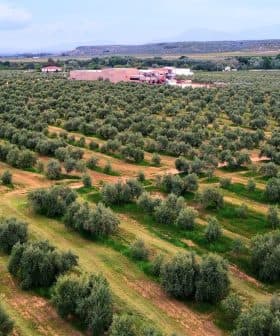 8.0K reads
8.0K readsWorld
Olive Council Forecasts Significant Production Decline
Global olive oil production is expected to hit a six-year low in the 2022/23 crop year, with a significant drop in yields across Western Europe and North Africa. While countries like Spain and Italy experienced production declines due to high temperatures and drought, Greece saw a record-breaking harvest, and the Middle East experienced significant production increases. Additionally, olive oil consumption is predicted to fall globally, with the United States and European Union expected to experience the most significant decreases.
The International Olive Council (IOC) estimates global olive oil production will hit a six-year low in the 2022/23 crop year, with output expected to reach 2.73 million tons.
Recently-published IOC data indicate that the world will produce 18 percent less olive oil this year than in the 2021/22 crop year total of 3.40 million tons. Furthermore, yields are 12 percent below the rolling five-year average of 3.14 million tons.
Precipitous drops in Western Europe and North Africa have fueled the significant decline.
See Also:2022 Harvest UpdatesThe eight main producing countries of the European Union combined to produce 1.50 million tons of olive oil, well below the 2.27 million tons of last year and 2.17 million ton average of the past half-decade.
Spain experienced the most significant decrease, with production falling to 780,000 tons, the lowest since the 2012/13 crop year.
Producers largely blamed high temperatures that damaged trees at the blossoming time and the effects of the unprecedented drought that stretched across Europe and North Africa.
While olives are notoriously drought resistant, many trees across the region did not receive the minimum amounts of water at critical moments in development, resulting in the trees dropping their fruit to preserve themselves.
Country | 2022/23 (t) | 2021/22 (t) | 5‑Yr. Avg. (t) |
|---|---|---|---|
Spain | 780,000 | 1,491,500 | 1,411,600 |
Greece | 350,000 | 232,000 | 262,600 |
Italy | 235,000 | 329,000 | 247,300 |
Portugal | 125,000 | 206,200 | 136,400 |
Cyprus | 6,100 | 4,000 | 4,800 |
Croatia | 4,400 | 2,900 | 3,600 |
France | 3,600 | 5,800 | 5,100 |
Slovenia | 700 | 300 | 600 |
European Union | 1,504,800 | 2,271,700 | 2,139,000 |
In Italy, traditionally the world’s second-largest producer, yields are expected to fall to 235,000 tons, the lowest since 2018/19.
Again, farmers blamed the drought and many olive trees entering an ‘off-year’ in their natural alternate bearing cycle.
Producers in Portugal and France also experienced production declines. In Portugal, yields fell from the previous year’s record high to 125,000 tons. Though much smaller in scale, France also saw production slip significantly to 3,600 tons. The drought was a significant contributor once again.
However, not every country in Europe saw production slip. Croatia, Cyprus and Slovenia all experienced modest production increases, though combined to produce just 11,200 tons of olive oil.
Outside of the E.U., Albania experienced a record-breaking harvest of 15,500 tons, while production in Montenegro remained steady.
On the eastern border of the E.U., producers in Greece celebrated the most fruitful harvest since 2006/07.
Producers expect to yield 350,000 tons of olive oil, significantly above the rolling five-year average of 262,000 tons.
Unlike its peers, producers in Greece enjoyed mild weather and appropriate rainfall. However, some faced issues with the olive fruit fly at the end of the season.
Plentiful rainfall at the right moments and mild summer temperatures also played a role in a series of record harvests and significant production increases across the Middle East.
Turkey became the world’s second-largest olive oil producer after a record-smashing harvest of 380,000 tons. While slightly less than the 400,000 tons initially estimated, officials remain optimistic that production will continue to rise as trees planted more than a decade ago enter maturity.
Shortly, producers in Turkey expect to raise the rolling five-year average of 223,000 tons closer to this year’s total.
Turkey’s southern neighbors, including Israel, Jordan, Palestine and Syria, also experienced production rebounds, with yields exceeding the rolling five-year averages.
After last year’s record-high, production fell slightly in Lebanon, equalling the rolling five-year average of 17,000 tons.
Despite stark warnings of future water stress across the region, producers in the Middle East largely enjoyed mild temperatures and enough rain, with many groves entering an ‘on-year’ in the alternate bearing cycle.
Country/State | 2022/23 (t) | 2021/22 (t) | 5‑Yr. Avg. (t) |
|---|---|---|---|
Turkey | 380,000 | 235,000 | 223,000 |
Tunisia | 180,000 | 240,000 | 257,000 |
Morocco | 156,000 | 200,000 | 169,000 |
Algeria | 81,000 | 91,000 | 93,400 |
Egypt | 40,000 | 20,000 | 35,700 |
Jordan | 27,500 | 25,500 | 25,100 |
Palestine | 23,000 | 17,500 | 21,200 |
Israel | 18,000 | 12,000 | 14,800 |
Lebanon | 17,000 | 21,500 | 17,000 |
Albania | 15,500 | 11,500 | 11,900 |
Libya | 15,500 | 16,500 | 16,800 |
Iran | 12,500 | 10,500 | 9,100 |
China | 8,500 | 8,000 | 6,800 |
TOTAL | 2,729,500 | 3,398,000 | 3,273,900 |
Along with Libya and Egypt, where production rebounded back to 40,000 tons after an abysmal harvest due to extreme weather in 2021/22, the olive oil production world’s center gravity shifted to the Eastern Mediterranean significantly this year. However, this is unlikely to remain the case for long.
While production fell in Tunisia and Morocco, both countries have invested in modernizing their agricultural techniques and growing more olive trees.
The IOC predicts yields in Tunisia will slip to 180,000 tons this year, 43 percent below the rolling five-year average, while Morocco has seen production fall to 156,000 tons, an 8 percent decrease.
Meanwhile, producers in Algeria saw a more moderate decline than initially expected, with production falling to 81,000 tons.
Outside the Mediterranean basin, production in Iran and China also significantly increased. While not yielding as much as initially expected, Iran produced a record-high 12,500 tons of olive oil. China also produced a record-high 8,500 tons of olive oil.
The IOC estimated that the United States would produce 15,000 tons of olive oil. However, producers in California, the state responsible for virtually all American olive oil production, told Olive Oil Times that they expected production to be far lower.
Along with a dip in production, the IOC also forecasts olive oil consumption to fall in many parts of the world. As a result, the IOC estimates that global consumption will be about 3.06 million tons in the 2022/23 crop year, the lowest total since 2017/18.
The United States and European Union are expected to experience the most significant consumption decreases, with consumption predicted to fall in the U.S. to 381,000 tons, its lowest level since 2018/19. Meanwhile, consumption is anticipated to slump to 1.41 million tons in the E.U., its lowest total since 2016/17.
Except for Germany, which saw a notable increase, consumption either remained steady, increased slightly or fell sharply in the rest of the bloc. Producing countries generally experienced more significant decreases.
This trend was also true among other Mediterranean and global-producing countries that also experienced production decreases. The most notable consumption increases are expected in Egypt and Syria.
Despite a decrease in olive oil production, global table olive yields rose to 3.10 million tons, exceeding the 3 million mark for the first time in five years. Greece, Egypt, Turkey, Peru and Syria recorded the largest increases. Conversely, significant decreases are expected in the United States and Spain.









